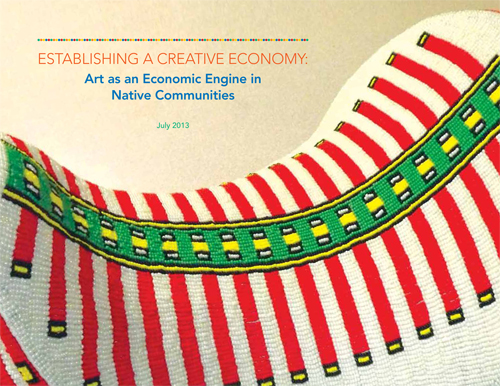Establishing a Creative Economy
Art as an Economic Engine in Native Communities
July 2013, 40 pages. First Peoples Fund, P.O. Box 2977, Rapid City, South Dakota, 57709, firstpeoplesfund.org.
Download:
![]() Establishing a Creative Economy (1.7Mb)
Establishing a Creative Economy (1.7Mb)
Based on market research conducted in Washington, Oregon, Montana and South Dakota, this report makes the case of Native arts as a strong and available economic force in Indian Country. For example:
- Art is deeply rooted in Native communities.
- An estimated 30 percent of all Native peoples are practicing or potential artists and most live below the poverty line.
- 51 percent of Native households on Pine Ridge Reservation depend on home-based enterprises for cash income.
- 79 percent of those home-based enterprises on Pine Ridge Reservation consist of some form of traditional arts.
- Native artists learn more effectively through informal networks (peer- and family-based training) than through formal networks (institutional training). In an Arts Lab, artists can obtain access to training, mentoring, materials used in the creation of arts, and physical and electronic marketplaces.
- Access to resources is a significant hurdle for Native artists to overcome. Given the remote and vast landscapes in which most Native artists live and work, access to supplies, capital, markets, Internet, studio space and other resources is limited to nonexistent. Support targeted at this hurdle will have an enormous positive economic impact.
This report also demonstrates how artists and their communities benefit when “the right kind of support” is made available.
Direct support for Native artists effectively increases their economic success.
- 61 percent of emerging artists report household incomes of less than $10,000.
- 7.5 percent of First Peoples Fund artists report household incomes of less than $10,000.
The report concludes that Native art is a viable industry with the potential to make a real and lasting difference in Native communities across the United States, and support programs exist to provide the opportunity for Native art to improve the economic lives of Native artists and reduce poverty. The challenge is increasing awareness and access to resources. There is ongoing national dialogue and research regarding the intersection of art and sustainable communities. Nonprofits, foundations and federal agencies have the ability to contribute the Native voice to the discussion, which will help inform these ongoing efforts and will benefit artist communities in rural and urban areas.

